Venerated in Catholic Church Buried Convent of Saint Gildard Nationality French | Name Bernadette Soubirous | |
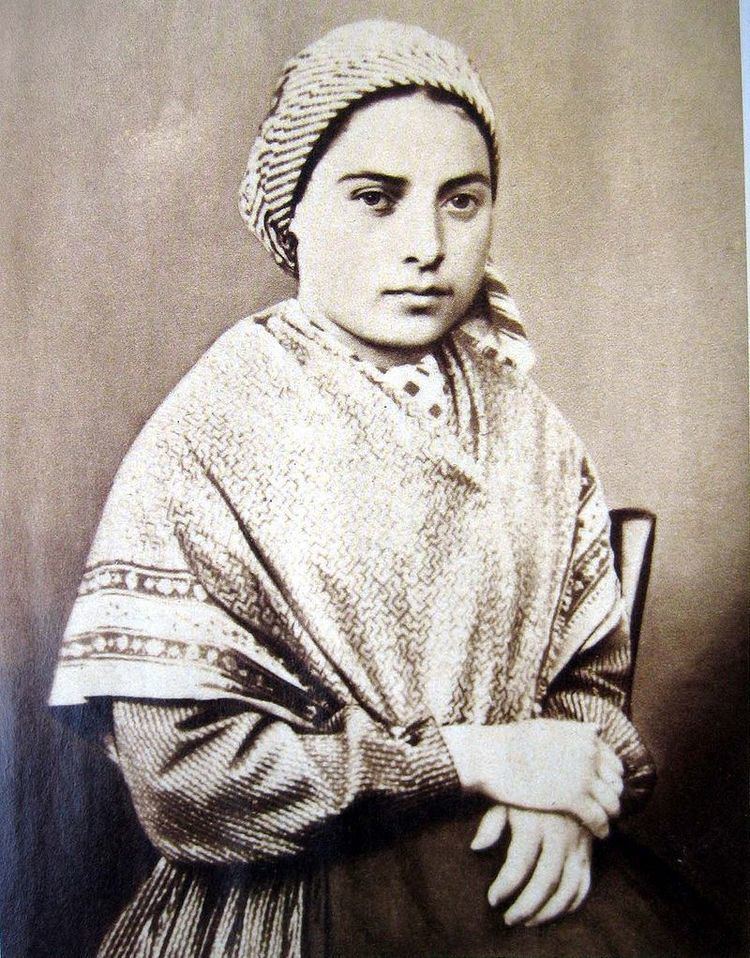 | ||
Beatified 14 June 1925, Rome, by Pope Pius XI Canonized 8 December 1933, Rome, by Pope Pius XI Feast 16 April11 February18 February (France) Patronage Bodily illness, Lourdes, France, shepherds and shepherdesses, against poverty, people ridiculed for their faith Died April 16, 1879, Nevers, France Siblings Toinette Soubirous, Jean Soubirous, Louise Soubirous, Justin Soubirous, Pierre Soubirous, Jean-Marie Soubirous Similar People Jennifer Jones, Dominique Peyramale, Henry King, Napoleon III, Franz Werfel | ||
Full name Marie-Bernarde Soubirous | ||
Bernadette soubirous movie 1 12
Bernadette Soubirous (Occitan: Bernadeta Sobirós; 7 January 1844 – 16 April 1879) was the firstborn daughter of a miller from Lourdes (Lorda in Occitan), France, and is venerated as a saint in the Catholic Church.
Contents
- Bernadette soubirous movie 1 12
- Bernadette Soubirous Part 1
- Early stages of her life
- Visions
- Results of her visions
- Later years
- Sainthood
- Exhumations
- In media
- References
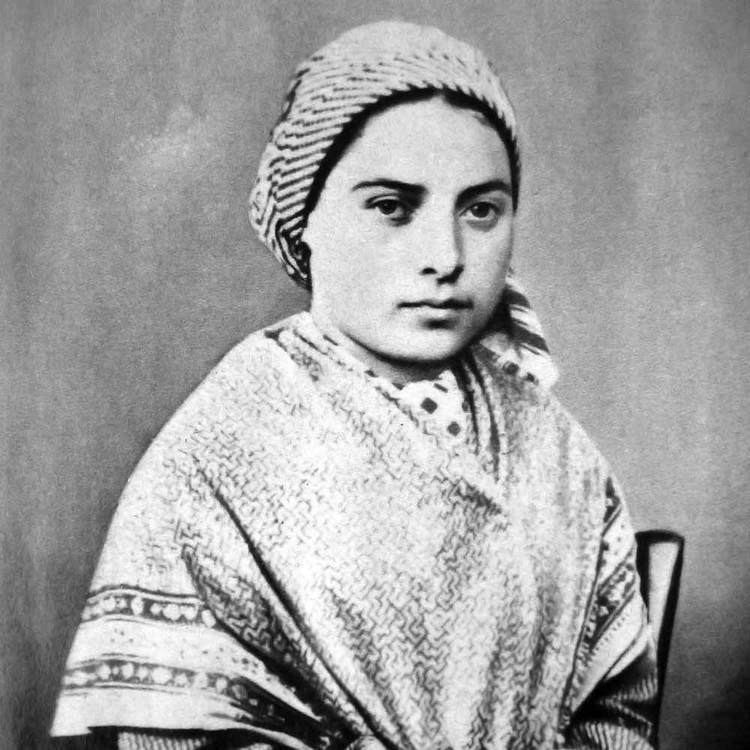
Soubirous is best known for the Marian apparitions of a "young lady" who asked for a chapel to be built at the nearby garbage dump of the cave-grotto at Massabielle where apparitions are said to have occurred between 11 February and 16 July 1858. She would later receive recognition when the lady who appeared to her identified herself as the Immaculate Conception.
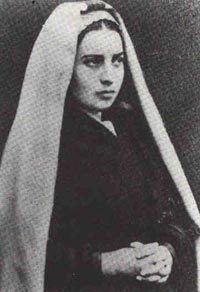
Despite initial skepticism from the Catholic Church, Soubirous's claims were eventually declared "worthy of belief" after a canonical investigation, and the Marian apparition is now known as Our Lady of Lourdes. Since her death, Soubirous's body has apparently remained internally incorrupt, but it is not without blemish; during her third exhumation in 1925, the firm of Pierre Imans made light wax coverings for her face and her hands due to the discoloration that her skin had undergone. These masks were placed on her face and hands before she was moved to her crystal reliquary in June 1925. The Marian shrine at Lourdes (Midi-Pyrénées, France) went on to become a major pilgrimage site, attracting over five million pilgrims of all denominations each year.
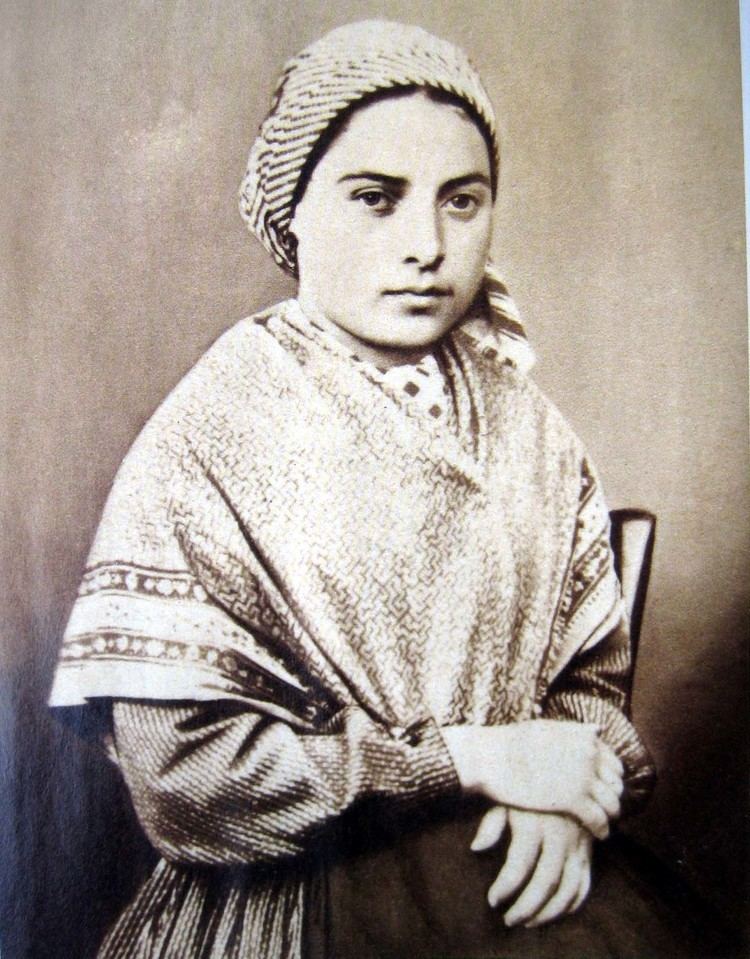
On 8 December 1933, Pope Pius XI declared Bernadette Soubirous a Saint of the Catholic Church. Her feast-day was initially fixed for 18 February—the day her Lady promised to make her happy, not in this life, but in the next—but is now observed in most places on the date of her death, 16 April.

Bernadette Soubirous ~ Part 1
Early stages of her life
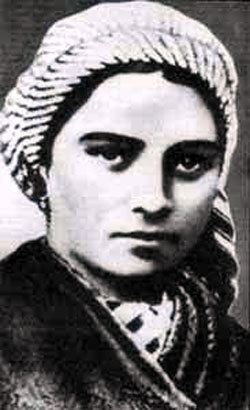
Maria Bernada Sobirós (Bernadeta) was the daughter of François Soubirous (1807–1871), a miller, and Louise (née Casteròt; 1825–1866), a laundress. She was the eldest of nine children—Bernadette, Jean (born and died 1845), Toinette (1846–1892), Jean-Marie (1848–1851), Jean-Marie (1851–1919), Justin (1855–1865), Pierre (1859–1931), Jean (born and died 1864), and a baby named Louise who died soon after her birth (1866).

Bernadette was born on 7 January 1844 and baptized at the local parish church, St. Pierre's, on 9 January, her parents' wedding anniversary. Bernadette's godmother was Bernarde Casterot, her mother's sister, a moderately wealthy widow who owned a tavern. Hard times had fallen on France and the family lived in extreme poverty. Bernadette was a sickly child and possibly due to this only measured 4ft.7in. tall. She contracted cholera as a toddler and suffered severe asthma for the rest of her life. Bernadette attended the day school conducted by the Sisters of Charity and Christian Instruction from Nevers. Contrary to a belief popularized by Hollywood movies, St. Bernadette learned very little French, only studying French in school after age 13 due to being frequently ill and a poor learner. She could read and write very little due to her frequent illness. She spoke the language of Occitan, which was spoken by the local population of the Pyrenees region at that time and to a lesser degree today (which is similar to Catalan spoken in eastern Spain).
Visions
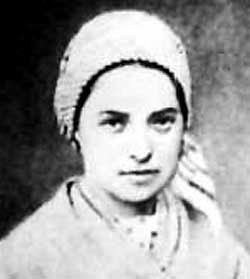
By the time of the events at the grotto, her family's financial and social status had declined to the point where they lived in a one-room basement, formerly used as a jail, called le cachot, "the dungeon", where they were housed for free by her mother's cousin, André Sajoux.
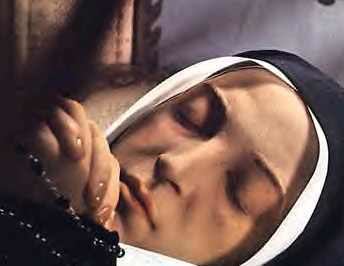
On 11 February 1858, Bernadette, then aged 14, was out gathering firewood with her sister Marie and a friend near the grotto of Massabielle (Tuta de Massavielha) when she experienced her first vision. While the other girls crossed the little stream in front of the grotto and walked on, Bernadette stayed behind, looking for a place to cross where she wouldn't get her stockings wet. She finally sat down to take her shoes off in order to cross the water and was lowering her stocking when she heard the sound of rushing wind, but nothing moved. A wild rose in a natural niche in the grotto, however, did move. From the niche, or rather the dark alcove behind it, "came a dazzling light, and a white figure". This was the first of 18 visions of what she referred to as aquero (pronounced [aˈk(e)ɾɔ]), Gascon Occitan for "that". In later testimony, she called it "a small young lady" (uo petito damizelo). Her sister and her friend stated that they had seen nothing.

On 14 February, after Sunday Mass, Bernadette, with her sister Marie and some other girls, returned to the grotto. Bernadette knelt down immediately, saying she saw aquero again and falling into a trance. When one of the girls threw holy water at the niche and another threw a rock from above that shattered on the ground, the apparition disappeared. On her next visit, 18 February, she said that "the vision" asked her to return to the grotto every day for a fortnight.
This period of almost daily visions came to be known as la Quinzaine sacrée, "holy fortnight." Initially, her parents, especially her mother, were embarrassed and tried to forbid her to go. The supposed apparition did not identify herself until the seventeenth vision. Although the townspeople who believed she was telling the truth assumed she saw the Virgin Mary, Bernadette never claimed it to be Mary, consistently using the word aquero. She described the lady as wearing a white veil, a blue girdle and with a yellow rose on each foot — compatible with "a description of any statue of the Virgin in a village church".
Bernadette's story caused a sensation with the townspeople, who were divided in their opinions on whether or not Bernadette was telling the truth. Some believed her to have a mental illness and demanded she be put in an asylum.
The other contents of Bernadette's reported visions were simple and focused on the need for prayer and penance. On 25 February she explained that the vision had told her "to drink of the water of the spring, to wash in it and to eat the herb that grew there," as an act of penance. To everyone's surprise, the next day the grotto was no longer muddy but clear water flowed. On 2 March, at the thirteenth of the alleged apparitions, Bernadette told her family that the lady said that "a chapel should be built and a procession formed".
Her 16th claimed vision, which she stated went on for over an hour, was on 25 March. According to Bernadette's account, during that visitation, she again asked the woman for her name but the lady just smiled back. She repeated the question three more times and finally heard the lady say, in Gascon Occitan, "I am the Immaculate Conception" (Qué soï era immaculado councepcioũ, a phonetic transcription of Que soi era immaculada concepcion).
Some of the people who interviewed her after her revelation of the visions thought her simple-minded. However, despite being rigorously interviewed by officials of both the Catholic Church and the French government, she stuck consistently to her story.
Results of her visions
After investigation, Church authorities confirmed the authenticity of the apparitions in 1862. In the 150 years since Bernadette dug up the spring, 69 cures have been verified by the Lourdes Medical Bureau as "inexplicable" — after what the Church claims are "extremely rigorous scientific and medical examinations" that failed to find any other explanation. The Lourdes Commission that examined Bernadette after the visions ran an intensive analysis on the water and found that, while it had a high mineral content, it contained nothing out of the ordinary that would account for the cures attributed to it. Bernadette said that it was faith and prayer that cured the sick.
Her request to the local priest to build a chapel at the site of her visions eventually gave rise to a number of chapels and churches at Lourdes. The Sanctuary of Our Lady of Lourdes is now one of the major Catholic pilgrimage sites in the world. One of the churches built at the site, the Basilica of St. Pius X, can accommodate 25,000 people and was dedicated by the future Pope John XXIII when he was the Papal Nuncio to France. Close to 5 million pilgrims from all over the world visit Lourdes (population of about 15,000) every year to pray and to drink the miraculous water, believing they obtain from the Lord healing of the body and of the spirit.
Later years
Disliking the attention she was attracting, Bernadette went to the hospice school run by the Sisters of Charity of Nevers where she had learned to read and write. Although she considered joining the Carmelites, her health precluded her entering any of the strict contemplative orders. On 29 July 1866, with 42 other candidates, she took the religious habit of a postulant and joined the Sisters of Charity at their motherhouse at Nevers. Her Mistress of Novices was Sister Marie Therese Vauzou. The Mother Superior at the time gave her the name Marie-Bernarde in honor of her godmother who was named "Bernarde".
Bernadette spent the rest of her brief life there, working as an assistant in the infirmary and later as a sacristan, creating beautiful embroidery for altar cloths and vestments. Her contemporaries admired her humility and spirit of sacrifice. One day, asked about the apparitions, she replied:
The Virgin used me as a broom to remove the dust. When the work is done, the broom is put behind the door again.
She later contracted tuberculosis of the bone in her right knee. She had followed the development of Lourdes as a pilgrimage shrine while she still lived at Lourdes, but was not present for the consecration of the Basilica of the Immaculate Conception there in 1876.
For several months prior to her death, she was unable to take an active part in convent life. She eventually died of her long-term illness at the age of 35 on 16 April 1879 (Easter Wednesday), while praying the holy rosary. On her deathbed, as she suffered from severe pain and in keeping with the Virgin Mary's admonition of "Penance, Penance, Penance," Bernadette proclaimed that "all this is good for Heaven!" Her final words were, "Blessed Mary, Mother of God, pray for me! A poor sinner, a poor sinner". Bernadette's body was laid to rest in the Saint Gildard Convent.
Sainthood
Bernadette Soubirous was declared blessed on 14 June 1925 by Pope Pius XI. She was canonized by Pius XI on 8 December 1933.
In the spring of 2015 the town of Lourdes lobbied for Bernadette's remains to be returned to Lourdes, a move opposed by the city of Nevers.
Exhumations
Bishop Gauthey of Nevers and the Church exhumed the body of Bernadette Soubirous on 22 September 1909, in the presence of representatives appointed by the postulators of the cause, two doctors and a sister of the community. They claimed that although the crucifix in her hand and her rosary had both oxidized, her body appeared incorrupt — preserved from decomposition. This was cited as one of the miracles to support her canonization. They washed and reclothed her body before burial in a new double casket.
The Church exhumed the corpse a second time on 3 April 1919. A doctor who examined the body noted, "The body is practically mummified, covered with patches of mildew and quite a notable layer of salts, which appear to be calcium salts. ... The skin has disappeared in some places, but it is still present on most parts of the body."
In 1925, the church exhumed the body for a third time. They took relics, which were sent to Rome. A precise imprint of the face was molded so that the firm of Pierre Imans in Paris could make a wax mask based on the imprints and on some genuine photos to be placed on her body. This was common practice for relics in France as it was feared that the blackish tinge to the face and the sunken eyes and nose would make an unpleasant impression on the public. Imprints of the hands were also taken for the presentation of the body and the making of wax casts. The remains were then placed in a gold and crystal reliquary in the Chapel of Saint Bernadette at the mother house in Nevers.
Three years later in 1928, Doctor Comte published a report on the exhumation of Blessed Bernadette in the second issue of the Bulletin de I'Association medicale de Notre-Dame de Lourdes.
"I would have liked to open the left side of the thorax to take the ribs as relics and then remove the heart which I am certain must have survived. However, as the trunk was slightly supported on the left arm, it would have been rather difficult to try and get at the heart without doing too much noticeable damage. As the Mother Superior had expressed a desire for the Saint's heart to be kept together with the whole body, and as Monsignor the Bishop did not insist, I gave up the idea of opening the left-hand side of the thorax and contented myself with removing the two right ribs which were more accessible. ... What struck me during this examination, of course, was the state of perfect preservation of the skeleton, the fibrous tissues of the muscles (still supple and firm), of the ligaments, and of the skin, and above all the totally unexpected state of the liver after 46 years. One would have thought that this organ, which is basically soft and inclined to crumble, would have decomposed very rapidly or would have hardened to a chalky consistency. Yet, when it was cut it was soft and almost normal in consistency. I pointed this out to those present, remarking that this did not seem to be a natural phenomenon.".
